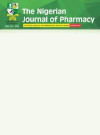Assessment Of Patient—Pharmacist Communication In A Tertiary Health Institution In North Central Nigeria
Keywords:
Patient-pharmacist communication, Information, Medication, AdherenceAbstract
Background: Good patient - pharmacist communication is known to increase medication adherence among patients. Hence, it serves as a means to improve patient adherence to their medication regimen. The study was conducted to determine whether improved patient-pharmacist communication in a tertiary health institution in North Central Nigeria will increase patients' adherence to their medications. This is with the aim of evaluating four contextual cues (patient age, gender, educational status and patient question asking behavior) which may be associated with the content of patient - pharmacist communication.
Method: A pretested questionnaire was administered on the 55 pharmacists in the institution. Three hundred and sixty (360) patient-pharmacist e nco unters were recorded, investigated and analyzed. The observation was carried out within a time interval of 4 hours (11:00am — 2:00 pm) daily on Mondays through Saturdays for a period of one month. Two observational check lists were used to observe the interaction between patients and pharmacists.
Results: Forty-one (74.5%) pharmacist responded out of the 55 pharmacists. Of the 360 patients (aged 1 — 82 years, average 34.6) observed, 208 (58%) were male and 152 (42%) were female. All the patients observed received information on availability of medicine, cost and route of administration, dose and dosing frequency. Some received information on; 12 (3.3%) on health condition, 12 (3.3%) on duration of use, 11 (3.0%) on drug interactions and 8 (2.2%) on side effects. No patient received information on indication, monitoring for effectiveness, contraindication or repeat visit. Only 63 (17.5%) asked questions (22.2% and 77.85 were illiterate and literate respectively).
Conclusion: The provision of pertinent information on medications to patients by pharmacists in the tertiary health institution is generally poor. Patient asking behavior was generally unsatisfactory.
References
Al-Shaqha WM and Zairi M (2001). Pharmaceutical care management: modern approach to providing seamless and integrated health care. International Journal of Healthcare Quality Assurance. 14(7): 282-301.
Helper CD (1987). The third wave in pharmaceutical education and clinical movement. American Journal o f Pharmaceutical Education. 51: 369-385.
Erah PO and Chuks-Eboka NA (2008). Patients' perception of the benefits of pharmaceutical care services in the management of hypertension in a tertiary health care facility in Benin city. Nigeria Tropical Journal of Pharmaceutical Research.7 (1): 897-905.
Magarinos C (2004). Industrial Development Report 2004: Industrialization, environment and the millennium development goal sinsub - Saharan Africa. United Nations Industrial Development Organization Vienna.
Erah PO, Olumide GO, and Okhamafe AO (2003). Prescribing practice in two healthcare facilities in Warri Southern Nigeria: Comparative studies. Tropical Journal of Pharmaceutical Research. 2:175-182.
Juergens JP and Basara LR (1994). Patient information: community pharmacists needs and perspectives. Journal of Tropical Hospital Pharmaceutical Manager. 14:47-57.
Wabe NT, Raju NJ, and Angamo MT (2011). Knowledge, attitude and practice of patient medication counseling among drug dispensers in North West Ethiopia. Journal of Applied Pharmaceutical Science. 1(7):85—90.
Layqah L(2018). The practice of counseling in pharmacy: patients' perspectives. Journal of Annal of Pharmaceutical Research. 7(4):472.
Offor I and Enato E (2011). Patents Assessment of Pharmacists Medication Counseling in a Psychiatric Hospital in Nigeria. Tropical Journal of Pharmaceutical Research. 10(4):507-516.
Erah PO and Bafor EE(2004). Assessment of pharmacist - patient communication in some healthcare facilities in Southern Nigeria. Nigerian Journal of Pharmaceutical Research. 3: 123- 124.
Scommer JC and Wiederholt JB(1995). A field participant and environmental effects on pharmacist-patient communication in community pharmacies. Journal of Medical Care. 33(6): 567-584.
Scommer JC and Wieder holt JB (1997). Th e Association of Prescription Status, Patient Age, Patient Gender, and Patient Question Asking Behavior with the Content of Pharmacist — Patient Communication. Pharmaceutical Research. 14(2): 145 - 151
Krueger JL and Hermansen-Kobulnicky CJ (201 1). Patient perspective of medication information desired and barriers to asking pharmacists questions. Journal of the American Pharmacists Association. 51 (4): 510—519.

Downloads
Views | PDF Downloads:
378
/ 173
Published
How to Cite
Issue
Section
License

This work is licensed under a Creative Commons Attribution-NonCommercial 4.0 International License.


